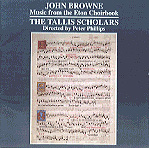Peter Phillips and The Tallis Scholars have brought many lesser-known English Renaissance composers to our attention by focusing entire recordings on such masters as Nicolas Gombert, Robert White, John Sheppard, and William Cornysh. This welcome (and rare) programming allows listeners to discern important and distinctive aspects of style, and by virtue of the first-rate performances backed by scrupulous scholarship, Phillips and his expert ensemble show these composers to be deserving of the same attention accorded their more illustrious comtemporaries. And here we have another, John Browne, who produced his known works in the late-1400s, and who is significantly represented in the Eton Choir Book–his eight-part O Maria salvatoris appears first. In fact, a polyphonic work in eight parts was “unprecedented”, and as you will hear during the course of this well-filled program (71 minutes), Browne was an absolute master of timbre and texture–and also was fond of the false relation and occasional surprising rhythmic shifts usually involving triplets.
In his excellent notes, Phillips suggests that among the compositional elements that Browne so elegantly and purposefully employed, “sonority” is the one that will most “forcefully” impress listeners. And he’s right. This is music whose textures and specific treatment of voicings make for unusually vibrant, powerfully resonant harmonies–and this is where anyone who tries to describe in words what the music sounds like will fall short. Such terms as “wall of sound”, “multilayered textures”, and “multifarious voicings”, all of which in some way are pertinent to Browne’s writing, just don’t go to the heart of what ultimately must be heard to be understood and appreciated.
Highlights include the six-part Stabat iuxta (Beside the cross of Christ, she stood), lusciously scored for TTTTBB and peppered with zinging dissonances, and the magnificent and dramatic Stabat mater. But surely, Phillips and his singers saved the best for last–the O Maria salvatoris is a soaring, emotionally affecting masterpiece that seems to contain everything that made Browne’s music so memorable–I especially liked the eyebrow-raising use of triplet figures and the lovely, floating treble lines. As we’ve come to expect, The Tallis Scholars deliver impeccably sung, appropriately dramatic and stylish performances, ideally recorded in the group’s favored venue, the Church of Saint Paul in Norfolk, England. If you don’t hear this, you’ll be missing one of the year’s best choral releases–and one of The Tallis Scholars’ finest CDs in its esteemed catalog. [4/30/2005]
































